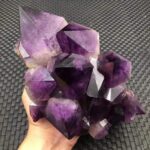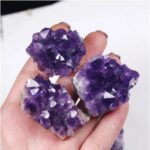Fluorite is a captivating purple gemstone that has entranced people for centuries. Beyond its beauty, fluorite holds a wealth of scientific and metaphysical properties that make it a highly sought-after crystal. Here’s an in-depth exploration of fluorite, its benefits, and its applications.

Physical and Chemical Properties of Fluorite
Fluorite, also known as fluorspar, is a mineral composed primarily of calcium fluoride (CaF2). It crystallizes in cubic or octahedral forms, often exhibiting vibrant colors ranging from purple to green, yellow, and even clear. The purple hue in fluorite is attributed to the presence of trace amounts of rare earth elements, particularly europium.
Fluorite exhibits a Mohs hardness of 4, making it relatively soft and easily scratched. Its specific gravity ranges from 3.0 to 3.25. Additionally, fluorite fluoresces under ultraviolet light, emitting a bright green glow.
Occurrence and Mining of Fluorite
Fluorite is a common mineral found worldwide, but major deposits are concentrated in a few regions. China, Mexico, South Africa, and the United States are key producers of fluorite. The mineral occurs in a variety of geologic settings, including hydrothermal veins, sedimentary rocks, and metamorphic rocks.
Mining methods for fluorite vary depending on the location and accessibility of the deposit. Surface mining is commonly used in open pit mines, while underground mining techniques are employed for deeper deposits.
Economic Significance of Fluorite
Fluorite is a valuable industrial mineral with numerous applications. The primary use of fluorite is in the production of hydrofluoric acid (HF), which is essential for the manufacture of glass, ceramics, and refrigerants. Additionally, fluorite is used in the production of steel, welding fluxes, and optical lenses.
The global fluorite market is estimated to be worth over $3 billion and is projected to grow significantly in the coming years due to rising demand from various industries.
Fluorite in Jewelry and Ornamental Uses
Fluorite’s vibrant purple color and unique crystal formations make it a popular gemstone for jewelry and ornamental purposes. It is often cut and polished into cabochons, beads, and carvings. Fluorite jewelry is particularly sought after for its metaphysical properties, which are believed to enhance spiritual growth and mental clarity.
In addition to jewelry, fluorite is also used in decorative objects, such as sculptures, vases, and bookends. Its ability to fluoresce under ultraviolet light makes it an eye-catching addition to any collection.
Metaphysical Properties of Fluorite
Fluorite is renowned for its metaphysical properties, which have been revered for centuries. Many believe that fluorite:
- Enhances intuition and psychic abilities
- Promotes spiritual growth and self-awareness
- Improves mental clarity and focus
- Reduces stress and anxiety
- Encourages creativity and imagination
These metaphysical properties are often attributed to fluorite’s ability to absorb and transmute negative energy. It is believed that carrying or wearing fluorite can help to create a positive and harmonious environment.
Healing Applications of Fluorite
In traditional healing practices, fluorite is often used to address a variety of physical and emotional ailments. Some of the purported healing benefits of fluorite include:
- Relieves pain and inflammation
- Boosts the immune system
- Detoxifies the body
- Improves dental health
- Helps with weight loss
While scientific evidence to support these claims is limited, many individuals find solace and relief in using fluorite for healing purposes. It is important to note that fluorite should not be ingested as it contains toxic fluorine ions.
Applications Beyond Traditional Uses
The unique properties of fluorite have inspired the development of innovative applications beyond traditional uses in jewelry and healing. Some of these applications include:
- Laser Optics: Fluorite is used in the manufacture of high-powered laser optics due to its low optical dispersion and high transmission of ultraviolet light.
- Plasma Etchers: Fluorite is essential for the production of plasma etchers used in the semiconductor industry. The plasma etching process relies on the chemical reactivity of fluorine ions to etch silicon wafers.
- Fluorinated Polymers: Fluorite is a key ingredient in the production of fluorinated polymers, which are non-stick, corrosion-resistant, and heat-resistant. These polymers are used in a variety of industrial and consumer products, including coatings, films, and gaskets.
- Novel Energy Storage: Researchers are exploring the use of fluorite as an electrolyte material in novel energy storage devices, such as solid-state batteries. Fluorite’s high ionic conductivity and stability make it a promising candidate for next-generation energy storage solutions.
Tables for Easy Reference
Table 1: Key Physical and Chemical Properties of Fluorite
| Property | Value |
|---|---|
| Chemical Composition | Calcium Fluoride (CaF2) |
| Crystal System | Cubic, Octahedral |
| Color | Purple, Green, Yellow, Clear |
| Hardness (Mohs) | 4 |
| Specific Gravity | 3.0 – 3.25 |
| Fluorescence | Bright Green under UV Light |
Table 2: Major Fluorite Producing Countries
| Country | Production (metric tons) |
|---|---|
| China | Over 50% |
| Mexico | 10-15% |
| South Africa | 5-10% |
| United States | 5-10% |
| Other Countries | <5% |
Table 3: Applications of Fluorite
| Application | Industry |
|---|---|
| Hydrofluoric Acid Production | Chemical Industry |
| Glass and Ceramics Manufacture | Construction, Automotive |
| Steel Production | Metallurgy |
| Welding Fluxes | Welding |
| Optical Lenses | Scientific, Medical |
| Jewelry and Ornaments | Fashion, Home Decor |
| Laser Optics | Technology |
| Plasma Etchers | Semiconductor Industry |
| Fluorinated Polymers | Coatings, Films, Gaskets |
| Novel Energy Storage | Research and Development |
Table 4: Metaphysical Properties of Fluorite
| Property | Benefits |
|---|---|
| Intuition and Psychic Abilities | Enhances spiritual connection and perception |
| Spiritual Growth and Self-Awareness | Promotes introspection and personal development |
| Mental Clarity and Focus | Improves concentration and reduces brain fog |
| Stress and Anxiety | Calms the mind and promotes inner peace |
| Creativity and Imagination | Inspires original ideas and expands perception |
Frequently Asked Questions (FAQs)
1. What is the best way to cleanse fluorite crystals?
Fluorite can be cleansed using water, salt, sunlight, or other methods. Avoid using harsh chemicals or detergents.
2. Can fluorite be exposed to sunlight?
Prolonged exposure to sunlight can cause fluorite to fade over time. It is best to keep fluorite in a shaded area or store it in a dark box.
3. How can I use fluorite for healing purposes?
Carry or wear fluorite close to your body to absorb its healing energies. You can also place fluorite in your home or workplace to create a positive atmosphere.
4. Is fluorite toxic?
Fluorite contains toxic fluorine ions and should not be ingested. Avoid handling fluorite with bare hands for extended periods.
5. What is the difference between fluorite and amethyst?
Fluorite is a calcium fluoride mineral, while amethyst is a type of quartz. Fluorite is typically purple, while amethyst is purple to reddish-purple.
6. How can I distinguish real fluorite from fake?
Real fluorite will fluoresce under ultraviolet light, emitting a bright green glow. Fake fluorite will not fluoresce.
7. What is the best way to store fluorite crystals?
Store fluorite crystals in a dry, dark place away from direct sunlight. Avoid storing fluorite with hard or sharp objects.
8. Can fluorite be used in water?
Fluorite can be placed in water for short periods, but it is not recommended to leave it submerged for extended periods.




























